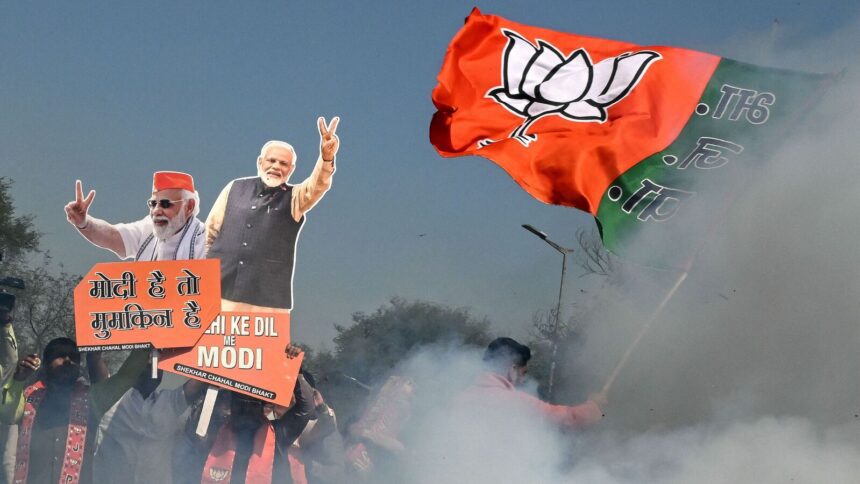After a prolonged wait of 27 years, the Bharatiya Janata Party (BJP) has achieved a significant victory, claiming 48 out of 70 assembly seats—an impressive increase from the mere eight it previously possessed. In contrast, the Aam Aadmi Party (AAP) has experienced a remarkable decline, dropping from 62 seats to just 22.
Read this |
To add further humiliation for the AAP, party leader Arvind Kejriwal was defeated in his New Delhi constituency by BJP’s Parvesh Sahib Singh, while former deputy chief minister Manish Sisodia lost his seat in Jangpura.
The election was essentially a clash between two contrasting narratives—AAP’s focus on extensive social welfare and freebies, popular among economically disadvantaged groups, versus the development agenda championed by the BJP under Modi, a hallmark of his leadership since rising on the national stage in 2013.
Prime Minister Modi’s pre-election announcement of various infrastructure projects in Delhi highlighted this strategy. Ultimately, the voters of Delhi called out AAP for its governance shortcomings—a complete lack of emphasis on infrastructure coupled with an overreliance on welfare programs.
Despite its sharp decline, AAP’s vote share remains noteworthy, indicating its sustained resonance among the economically and socially weaker demographics in Delhi. According to the Election Commission of India, AAP garnered 43.21% of the vote, a decrease from 53.6% in 2020. Meanwhile, the BJP’s vote share rose to 47%, up from 38.5% in the previous election.
The Congress party, on the other hand, has registered its third consecutive defeat, seeing a minor increase in its vote share—from 4.3% to 6.43%.
The BJP Rise
Three significant factors contributed to the BJP’s historic victory in Delhi, a win that has eluded it for almost three decades.
Firstly, Modi’s immense popularity in Delhi remains unparalleled. This is evidenced by the BJP’s outstanding performances in the Lok Sabha elections over the last three terms, where it won all seven seats. What played in the BJP’s favor this assembly election was a clear anti-incumbency sentiment directed at AAP, along with serious criticisms of Kejriwal’s governance model, elevating Modi’s approach to prominence. Even AAP supporters on the ground acknowledged a preference for Modi at the Centre.
Read this |
For BJP voters, the decision was straightforward—vote in the name of Modi. They showed little concern for the absence of a BJP chief ministerial candidate. “Modi ki guarantee hai“, they asserted. In the end, Modi proved once again to be the BJP’s greatest asset.
Secondly, the middle and upper-middle classes appear to have decisively backed the BJP. The glaring absence of infrastructure development under Kejriwal, coupled with AAP’s frequent conflicts with the Centre and certain tax incentives, provided the BJP with a notable advantage.
For the middle and upper-middle classes, Kejriwal’s anti-corruption and disruptive rhetoric had become more of a nostalgic idea than a pragmatic governance option. After ten years in power, AAP seems to have lost its attractiveness among this demographic.
Thirdly, voter fatigue with a decade-long incumbent afforded the BJP—the only significant alternative—a substantial head start. Additionally, the structure and grassroots presence of the BJP, along with the extensive network of the Rashtriya Swayamsevak Sangh (RSS), provided it with the organizational strength that AAP lacked.
The AAP Decline
AAP faced a particularly challenging election landscape—anti-incumbency sentiment, imprisonment of its key leaders, and a lack of administrative experience all played against it. However, there are two key takeaways for Kejriwal and his party.
First, a skewed governance approach that prioritizes benefits over development has its limits. Many voters, including previous AAP supporters, noted significant deficiencies—ranging from a lack of infrastructure progress to neglect in tackling pollution and waste management. Recurring complaints about roads, drainage, and civic issues turned against the Aam Aadmi Party.
Second, although AAP’s support base among the lower-classes remains intact, it is faltering as it seeks to attract higher economic strata. The BJP has been poised to capitalize on this gap, while AAP has failed to prevent its supporters from drifting away.
The Congress Consistency
Meanwhile, with a third successive defeat, the Congress party has shown remarkable, albeit unenviable, consistency.
The party was never a serious contender in this election. Voters on the ground dismissed it entirely, while fondly recalling its former chief minister Sheila Dikshit. The Congress has failed to build on her legacy of effective governance, squandering any potential advantages it might have possessed.
It failed to provide voters with a compelling reason to turn to it as an alternative to AAP or BJP, lacking a coherent narrative.
The Future Ahead
From a setback in the Lok Sabha elections to three consecutive assembly victories—Haryana, Maharashtra, and now Delhi—the BJP has demonstrated its resilience, setting it up favorably for upcoming elections in states like Bihar, West Bengal, and Uttar Pradesh. With this win, the BJP leadership is likely to invest substantial efforts into revolutionizing infrastructure in the national capital, aiming for a striking transformation.
Also read |
Yet, the biggest uncertainty looms over the AAP, for whom this election was a crucial survival battle. Despite emphasizing development (vikas), the BJP is unlikely to abandon its strengths in social welfare (jan kalyan). This compels Arvind Kejriwal to rethink his political strategy while simultaneously working to consolidate and expand his party’s still impressive vote share.










